Tags

“A ship landing on a whale mistaken for an island in an early thirteenth century bestiary (London, British Library, Harley MS 4751, f. 69r, c. 1230-1240).”
Much of this blog Word Nerdery built on a previous blog Word Nerds and reflects the orthographic journeying of my Grade 7 humanities classes. For 18 years I have been a fellow inquirer on this wordy quest. I have learned from my students and their questions, as well as from my word wayfaring colleagues around the world who pursue the truths of the English language in their classrooms. My journey in the classroom in Kuala Lumpur has finished and as with all travellers when they reach a fork or a crossroad in their journey, I reflect on the path travelled.
So why is orthographic inquiry important?
One student laughed and groaned during a class discussion, “You always bring everything back to words”. And it’s true – inevitably all paths lead to Rome, well to Latin, but also to Greek, Old English, Norse, Arabic, Hebrew, and the many other languages that add spice and flavour to English! So yes, groaning student, it does all come down to a word that when analyzed and considered, will deepen our understanding and thereby enrich our discussions!
‘Orthography’ refers to the conventional writing system of a language by which sense and meaning is conveyed to and by its native speakers. The word entered English in the mid 15th century with a denotation of ‘correct and proper spelling’ via Old French and before that Latin orthographia which had adopted it from Greek ὀρθογραϕία as you may have assumed from the <ph> digraph that represents the phoneme /f/. This grapheme is reliably a clue as to Hellenic origins. ‘Orthography’ is a connected compound comprised of four elements – two base elements , the first bound, the latter free, formed from Greek ‘orthos‘ correct and ‘graphein’ to write. A connecting vowel letter <o> links the two base elements: <orth+o+graph+y> .
In English orthography three components are connected and unified: morphology, etymology, and phonology. However, it’s morphology that’s the organizing, delimiting and defining concept. All orthographic units and elements are contained within morpheme boundaries. The other concepts especially phonology cannot be properly understood without the morphological framework .
Orthographic inquiry goes way beyond the dictates of a curriculum document. It goes beyond marshalling the various graphemes into correct order. Words are ‘human thought made visible’ (Real Spelling). Words are, as one student stated, ‘treasure chests just waiting to be opened’.
I can only present orthographic inquiry in the light of my experience of it in the classroom and its impact on my students and myself in our quest to understand text and write clearly. Here is what we understand from our journey:
- contained in one word are connections to other words related through a shared root and oftentimes a shared base element. Like us, words travel and in their travelling they too are changed.
- words grow – additional senses are added as the words travel both through different cultures and time. They reflect the past but are not static – they pick up influences from the countries they journey through and oftentimes they, like many migrants, while maintaining a link to their origins assimilate to the constraints, the form, of their adopted language. So they too have a story to be told. And when one understands words – their structure, their relatives (the morphology), understands their stories, and the way the morphology and etymology impact the graphemes and phonemes, you can begin to use them well. We have seen that words grant us power to move others, to persuade, to bring laughter or tears or fear or hatred or compassion.
- uncovering the roots and finding a word’s relatives helps us read deeply. Metaphors uncovered in the roots run like a bloodline through related words and help to reveal the depth of a poem or text. Recently one student uncovered the metaphor of cards thrown away, in the word ‘discarded’. Another student found love buried in the related words ‘belief ‘and ‘believe’. Another found footprints in ‘investigation’.
- the spelling of words make sense—there are no ‘oddballs’, ‘demons’ or ‘irregular’ words. There is a reason behind the structure of all words.
How did we go about this?
In the space of a year, our questing has been daily. From day one I used the linguistic terminology of orthography: morphological terms such as base elements – free, bound, morphemes, elements, prefixes, suffixes (derivational, inflectional) etymological terms such as roots, clip, blend or portmanteau words, eponyms and toponyms, etymological marker letters, Latinate, Old English, Proto Indo European and phonological terms such as phonemes, phone, along with graphemes- digraph and trigraph, and the general terms lexical and function words.
We talked from the very beginning about roots and the languages that flavour English. We have talked about periods of the past and we sought truth by justifying all our hypotheses with evidence. We revised our hypotheses, often! Always our inquiry was intertwined, embedded into the classroom focus—based around a text—a poem, a picture book, one of the novels, a history reading, an event from a basketball game to saving turtles or rhinoceroses. There was never a list, an ordered set of conventions to be taught, rather words deemed important or intriguing were selected by the students or me for investigation. In considering one word, inevitably we considered hundreds. In exploring the one word, we uncovered the patterns and conventions that apply to hundreds of words. In all our forays, we found only the orderliness, the sense and the structure of English.
Word investigation has bound us together, been the fabric running through every class. Sometimes the analysis in the form of a word sum may remain on our board for several weeks with students critiquing this and offering various hypotheses as to morphemes. Sometimes I get emails from students who have taken it upon themselves to look further and share the relatives they have uncovered. Sometimes students drop in to discuss a word before school or during lunch and yes, even after school. Often, without reminders from me, I see small scribbled conjectures in the form of word sums in their notebooks or on scraps of working paper lying around the room – this is now how they think about a word when uncovering its meaning. Understanding of orthographic structure is built incrementally over time not in a prescribed one-off, stand alone lesson.
Through the course of a year students learn to read etymology dictionaries – The Online Etymology Dictionary has become a familiar friend; they read the Oxford English Dictionary. Students read the denotation and searched for a common root that tied a family of words together. Who would have thought ‘cull’, ‘legume’ and ‘collection’ could be related? Or ‘hope’ and ‘hop’? Who too would have connected ‘impale’ and ‘peace’ as being etymologically related? But dig deep as these students have and discover the connections of meaning that echo throughout. We talk about ‘resilience’ and read a dictionary denotation, but knowing it has evolved from Latin salire- saltum ‘ leap’ and that this root has lead to words like ‘saute’, ‘assault’, ‘assailant’, ‘somersault’, ‘desultory’, ‘insult’ and even ‘salmon’, all carrying the connotation of leaping and springing, adds richness and vibrancy to texts.
Always our inquiries into a word were framed around four questions concerning meaning, structure, relatives and pronunciation:
What does it mean?
How is it constructed?
What are the relatives? A relative must share a common root. A morphological relative shares the same base element – such as hopelessly <hope+less+ly> and unhopeful <un+hope+ful> or construction <con+struct+ion> and destructive <de+struct+ive>. An etymological relative shares the same root but may have a different base element such as hopeful and hop or destruction and destroy and construe. You’ll notice that all relatives have sense of the root buried in them – a faint echo of meaning that unites them as a family. So the present day bases <strue>, <struct> and <stroy> carry a sense of building, piling up.
What are the elements of pronunciation that effect meaning? This question allows us to explore the grapheme – phoneme relationships which are driven by morphology and etymology.
Read the comments below from the final investigations as students chose a word to sum up their grade 7 humanities experience:
‘I chose to analyze and reflect on the word ‘belief’. The word is a free base along with its very close relative ‘believe’. In the past, ‘belief’ used to contain a prefix and a free base element <be +lief>. That free base element has faded from use now. The word ‘belief’ first came into English in the late 12 century. It came into English as ‘beleave’ meaning “confidence reposed in a person or thing; faith in a religion.” It took over Old English ‘geleafa’ meaning “belief, faith.” The word goes all the way back to a PIE root *leubh meaning “to care, desire, love”. When I clicked on the link of the PIE root, I got some related words that were very, very interesting such as ‘love’ and ‘lovely’. I then thought about the belief of love and the definition of belief that might relate to these words. The definition for belief is “trust, faith or confidence in someone or something”. To believe in something or someone is to hold to them to your heart and think positively about them. This made me think that when you love something or someone, you hold them to heart and you trust them. An antonym for the word belief is ‘disbelief’. It means to not believe in anything or to stop believing in something.
The word belief greatly relates to this year in seventh grade because we thought about it through every unit. In the first unit, when we studied Odysseus’ journey and the other Greek heroes’ adventures, I saw how the word belief relates to this because these heroes believed that they could get home. Their belief in the gods greatly impacted how they lived. In the next unit, we talked about religions and belief in all its connotations connects here. We studied how different religions go around each other and are similar in some ways. Finally, in the latest unit, we focused mainly on the Holocaust and which was caused by judgments based on beliefs. Jews were discriminated only because of what they believed in and the way they lived their everyday lives. Others did not believe strongly enough in humanity to stand up for the right to one’s own beliefs … Reading and studying this shocked me so much because of how humanity can treat each other for just one simple difference or different beliefs.When people aren’t educated, this brings differences and they make them stand out. This often brings them to misunderstand different religions and therefore conflicts begin. Division and bringing out differences dehumanizes some people just because of what they believe in. I now respect and embrace different people’s religions and take it to heart if someone is making fun of another religion or a difference in someone else.’ (Delphine)
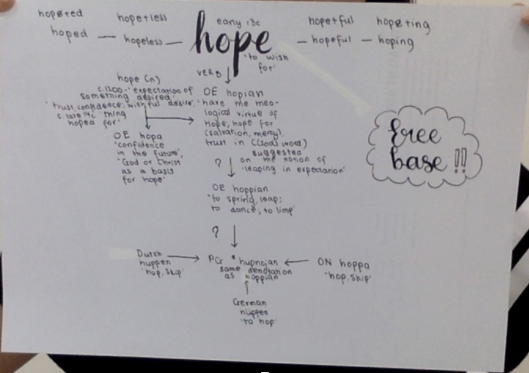
‘The word I chose to represent this year is hope. Although it seems such a simple word, with only a single morpheme, it carries a lot of power. Grade 7 Humanities has taught me that hope is an extremely powerful thing. “Happiness can be found in the darkest of times, if only one remembers to turn on the light.” – Albus Dumbledore. We read about the story of twenty-one Jews who spent over a year living in the terrible conditions of sewers in Nazi Poland. All around them, even in their own families, people were dying, but 10 finally emerged sane and alive. They did it by promising each other that they would one day taste freedom and lived off of the hope that they could one day experience it again, just like the people walking above their heads only a few meters aways. Odysseus spent seventeen years lost at sea, hated by the gods, but never once did he give up on getting back home, because he hoped that his son and his wife were still in Ithaca, waiting for him. It’s scientifically proven that with hope, patients have the ability to heal faster and easier. Individuals with hope significantly enhance their likeness from recovering from an illness. I’ve learned that hope can keep you alive. Hope is contagious, and the hope of one person can be an inspiration to many. ‘Hope’ and its relative ‘hop’ come from a root with the meaning ‘to spring, to leap’ and it certainly does make spirits soar.’ (Ee Jenn)
We have learned to handle orthographic analysis—through word sums to show evidence of the elements—affixes, base elements:
We show relationships in webs:

Create matrices to indicate the morphological (synchronic) relationships:

Matrix <form+ed>by students.
Create word trees to reveal an entire family ( reveal diachronic relationships).
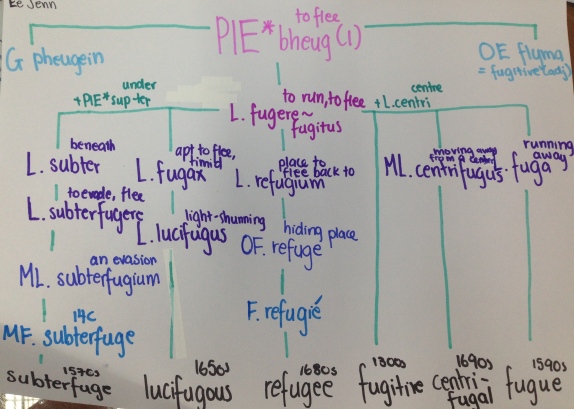
Watch and listen to this seventh grader’s research around the word discarded.
Consider the work below of Jae and Julia and how this orthographic way of thinking seeps into their writing.
Jae selected the word abandon as a crucial idea running through Shaun Tan’s text the Lost Thing we were exploring in class.
Initially Jae hypothesized <a + ban + don(e) + ed> and justified the prefix <a-> with words like away, ascend. He struggled with the next two elements as he came to realize that abandon was not a compound and could not account for the <don(e)> in sense and meaning and so came to <abandon+ed>. He read and understood that this word was Latinate entering English via Old French abandoner which developed from a French phrase . Jae went further to follow its tracks back to Proto-Germanic roots and the PIE root *bha- to speak.
We discovered that abandon as a verb was attested in 1293 ( OED) with a sense of ‘to give up or relinquish completely’ and that the sense of to ‘desert or forsake (a place, person, or cause); to leave behind’. The sense of ‘ to leave without help or support ‘was a later addition ( 1475 says OED). Digging around in the richness of OED we found ‘aband’ which provided evidence for <a+band+on>. We also discovered archaic bandon, ‘Jurisdiction, authority, dominion, control; power of disposal, full discretion, or authority to deal with. to be in or at any one’s bandon: to be under his control, at his disposal, will, or pleasure. To have a thing in one’s bandon: at one’s full or free disposal’.
Although faded from regular use now, the fact that this had been attested suggests that the base element is <band>, a bound base. The Old French word was formed from the adverbial phrase à bandon “at will, at discretion,” from à “at, to” and Old French bandon “power, jurisdiction,” evolving from Latin bannum,‘public proclamation, edict, interdict,’ This Latinate word was however, adopted from Germanic *bannan. It is related to ‘ban’, as well as other Latinate words contraband , bandit and banns, banish and banal. The PIE root *bha- to speak spawned a vast clan. The Latinate relatives including infamy, fable, infant, nefarious, nefandous, fatuous and fate and the Hellenic relatives euphemism, dysphemism, cacophony, phoneme and xylophone, give a glimpse of the spread of this speaking, talking, proclaiming family.
Having analyzed morphemes, uncovered the root and the diachronic and synchronic relatives, this student then turned his thinking once more to the text, The Lost Thing by Shaun Tan, that had provoked his inquiry. He wrote:
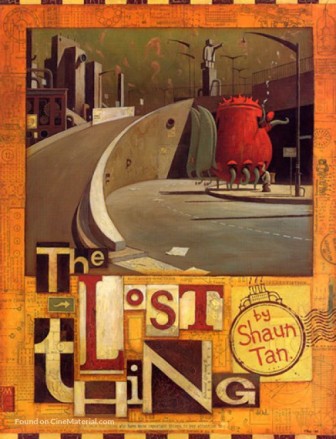 ‘The idea of abandonment is played out through ‘The Lost Thing’ over and over again. The lost thing is abandoned, deserted in a strange and unfamiliar city. Because nobody wants to help it, it becomes gradually more lost—losing a sense of its surroundings, and perhaps itself too. When examining the etymology of the word, we can trace it back to one of its ancestors, Proto-Germanic *bannan. This means ‘proclaim, summon, outlaw’ —the lost thing is made an outlaw solely because it’s.. lost.
‘The idea of abandonment is played out through ‘The Lost Thing’ over and over again. The lost thing is abandoned, deserted in a strange and unfamiliar city. Because nobody wants to help it, it becomes gradually more lost—losing a sense of its surroundings, and perhaps itself too. When examining the etymology of the word, we can trace it back to one of its ancestors, Proto-Germanic *bannan. This means ‘proclaim, summon, outlaw’ —the lost thing is made an outlaw solely because it’s.. lost.
This acts like a black label in society, causing its abandonment to become more troubling. When ‘Shaun’ takes the lost thing home, his parents persuade him to abandon it. They are too busy going on with their daily lives to care or feel troubled about the lost thing. This sense of becoming lazy and complacent in society leads things to be abandoned, just like the big, friendly, and red creature found in this peculiar city.
When something is abandoned, we cease to see the worth in it – we lose our sense of care and love for the thing that we must have once felt differently about. We fail to speak for it. Perhaps it’s in our nature to abandon something when it gets… boring. Like a child with a new toy, it only can be entertaining for so long. Things get abandoned every day, for different reasons.
I feel that ‘The Lost Thing’ represents this very idea – of people being swept up in their lives, but not swept up by its excitement – no, in fact, swept up by the same, old, dull lifestyle. They don’t notice the lost thing which stands out brightly with its curvy edges against the blocky horizon, or its bright red colour against the grey of the pavement.
We should not let our senses become dull to small details and fine changes, because once we are blinded to difference, we will abandon anything – not because we want to, but because it’s invisible to us.’
Finally he wrote the ‘tiny tale’ below that further illustrates his understanding of the word ‘abandon’.
‘We don’t fit in. Our voices do not blend with the others. We do not and cannot sing their songs. We are the abandoned – dejected, rejected and ejected.’ ( Jae)
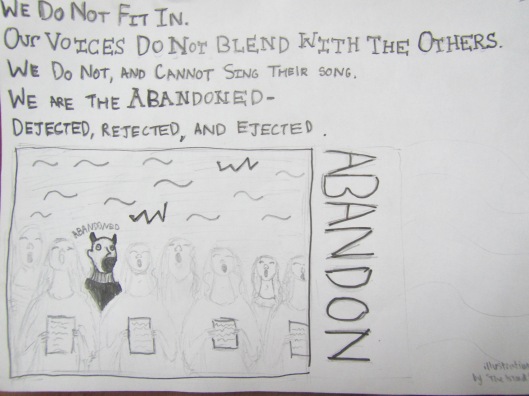
Below Julia has pursued her inquiry around the word ‘humanity.’ Note how she has hypothesized through word sums, and created a word tree to find roots and related words, both synchronic and diachronic.
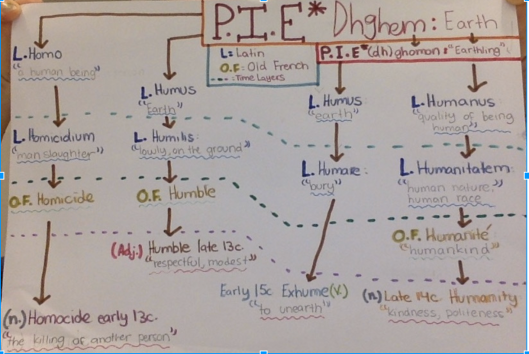

Following this she wrote:
‘When I look back at my year in 7th grade, there is also a word that I think always lay hidden beneath any unit, project, material, or assessment. It was the word ‘humanity’. This word seems to be what connected our three different units as a whole.
Throughout the units, we kept in mind questions like: What did humanity do? How did humanity tackle a problem? How can humanity improve? What is humanity, and how do we weigh its value? For example, In the Mythological Journey, we asked ourselves what makes a hero? However, at the same time, we also confronted the idea of how humanity could become a hero as a whole, instead of just a group of people. It was a little bit different in the religious journey, as we looked at how humanity was different yet had similarly connected through the aspects of religion. We had looked at humanity realistically and fictionally, but what happened when we looked at it historically? In our historical Journey, we saw how humanity could transform into the most gruesome being in the world, just by a simple act of manipulation, and the power to unite people through the cause of discrimination and scapegoating. We saw humanity as a whole who we were and what we had become, but one aspect we didn’t touch was the future humanity because we couldn’t predict actions that hadn’t already been made. We could only learn from those in the past, but this information is enough to make us, the future generation, understand how to respect and control humanity. Because, humanity is one of the most beautiful creatures in the world, but if you trap it inside a wall of lies, humanity becomes vile. That is what we have seen, and now it is our turn, to make it an obligation to never trap humanity with lies ever again.
When you start to understand the deeper meaning of a word it is like you were to look at the word in an entirely different manner. This is what I discovered when I annotated the word ‘humanity’. I realized that the word ‘humanity’ actually stems all the was back to a PIE* root called *dhghem, which meant “earth”. I thought of it as quite funny how the word humanity, which means human race, could stem back to a word meaning: ‘earth’. On the other hand, as I started to think with my more poetic mind, it actually made quite a lot of sense., because when we were in the Mythological Journey, I learned that humans were made from clay. And as we all know clay is made by dirt mixed with water, and where does dirt come from? The earth! It all made sense! We humans technically stem from the earth! Words are so magnificent if you are able to uncover their secrets.’
Read more tiny tales that came after research into words that students regarded as the essence of Tan’s The Lost Thing: discarded, conformity, belonging, lost, sympathy, forgotten, uniformity, acceptance, oblivion.
We have charted our ways through orthographic seas, but unlike the thirteenth century seafarers above who mistook a whale for an island, we have learned to recognize the English language for what it is: a living, evolving organism. We have not constrained orthography to phonology or regarded ‘phonics’ as a safe landing. Rather we have recognized the unity of the three components – morphology, etymology and phonology and thereby experienced the order and sense of a spelling. These seventh grade students and their teacher have found their way in a world of words.
And to my fellow educators and students – continue to wonder about words, question everything. Do not fall prey to the banal or become tempted by the quick and easy. Think and dream about morphemes and follow the vestiges, the footprints, through other times, other places and hear the murmur of humanity.


Ann, of all the gorgeous pieces you have shared, this, to me is the most gorgeous. And thanks to your students for the depth of their work and their eloquence in sharing their understanding.
LikeLiked by 1 person
I cried twice today. Once while reading a friend’s description of a date with his wife on their anniversary. It was a virtual date, as she passed away recently due to cancer. He loved her so much. And now this. I have no words. All I can come up with is love.
LikeLike
You have ‘set the bar’ so to speak with your students this year. Every teacher should be reading this and every student should be aspiring to the depth of understanding and scientific thought that goes on in your classroom. Beautiful hardly does it justice. Amazing barely gets closer. Sensational. Magnificent. Brilliant.
LikeLike
Belief, hope, abandon, humanity: what a perfect collection of words to name what orthography might reveal to us. Just beautiful.
LikeLiked by 1 person
I love how the words your students chose to study came right from what they were reading, or learning about, and then how what they learned from their word study is applied right back to a better understanding of what they read. Thank you!
LikeLike
Wow, Ann. What you have accomplished in your 18 year journey (so far!) of investigating humanity and orthography with your students is truly astonishing. I feel so honoured that I got to meet you near the beginning of this journey when I was first dipping my toes into these rich orthographic waters.
To bring this chapter of your journey to an end by with this celebration of learning that reflects and coveys the depth of that story in a single, brief post is itself a testament to what you have learned along the way.
You will never know the extent of the effect you have had on those 18 classes of students who were lucky enough to collaborate with you on this journey. And through your eloquent sharing of that learning over the years, that effect is exponential. I, for one, will be making this post required reading for the 5-day university course I’ll be teaching in Alberta this month. The seeds of learning you have planted over the years will bloom for countless learners you will never get to meet.
I know that your work will simply take a new form on your return to Melbourne. Looking forward to joining you on that journey as well!
Like your students, we owe you a great debt of gratitude for the gifts you have given us all.
LikeLiked by 1 person
Thankyou so much for reading this post Pete. It seems a mere blink ago when we first began this orthographic journey. Like you, I remember vividly the impact of that first revelatory encounter with Real Spelling – it was as if cataracts had been removed from my eyes – everything became sharply focused and clear. For months I couldn’t read — all I could see were prefixes, suffixes and base elements!! Thankyou Pete for your constant championing of the sense and order of spelling, for the rigorous way you analyze words and push all, students and teachers, to consider the elegance and sense of English word structure.
I am excited about where the path on this wordy adventure takes me next.
LikeLike
I look so forward to the next part of our journeys, and the new ways they will interconnect!
LikeLiked by 1 person
Ann: the depth and the beauty of these investigations are striking. You are a master at writing, retelling, and understanding our English orthography. Thanks for sharing and most of all for challenging students as well as us.
LikeLiked by 1 person
Ann, thank you for this. I have always looked to your blog to learn more and to get ideas of how to enrich the orthographic studies my students conduct. I have been especially intrigued and fascinated by the masterful way you continue to talk about the words long after the initial inquiry. You continue to tie the words to different situations and events, and in doing so, the words become alive and breathe meaning into text. The orthographic investigations are fascinating in and of themselves, but are so much more powerful when used to give the comprehension of a word, sentence, paragraph, or story depth. When studying orthography, a student becomes equipped to understand spelling, but also to read, think, and write. Bravo!
LikeLike
Mary Beth thankyou for reading my posts and being such a supporter of orthography. I love it when students make those connections between a word and the texts or the other curricular work they are studying. It’s been a privilege to work with words and students in this way. As you know orthography is human thought made visible!! Thankyou also Mary Beth for having the courage to plunge into those orthographic waters and inviting us into your classroom to show the joyous exploration of words and how this deepens thinking.
LikeLike
Beautifully written Ann! Your journey has inspired so many more than the students inside the 4 walls of your classroom because you write about it. Thank you for taking the time to weave eloquent stories about your learnings. I enjoy reading this one over and over again. It has been added to the Pinned Post on my SWI FB page and as suggested reading in my Intro class.
The gifts you’ve given your students by being scholarly with them and guiding them into becoming scholarly will continue to open themselves up as these young minds grow into adults. You’ve given a true gift, one that keeps on giving.
LikeLike